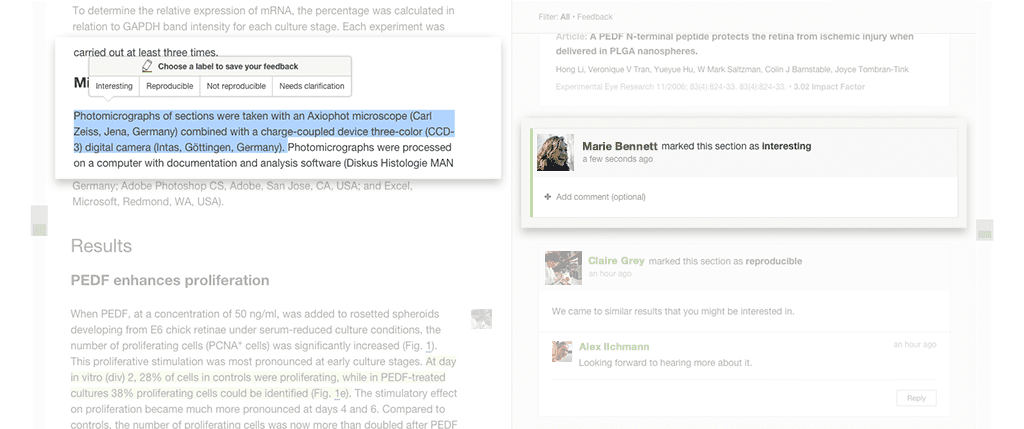
Ijad Madisch a Harvard trained virologist and computer scientist was on his way to becoming a medical professor, but in 2008 he put a halt to his career as a medical researcher to embark on an even greater challenge: changing the way scientists connect. To this end, he co-founded ResearchGate, an online platform where scientists can upload and share papers, connect with their peers and ask questions. Today, some six million researchers use ResearchGate, and by 2016 every scientists in the world could be a member of the social network.
ResearchGate (RG) is atypical, as far as social networks go. It aims to effectively change the way science is being disseminated and usher in a new age of digital communications among scientists. For instance, one big hurdle in the way of scientific progress is the bias towards positive results in published papers, something ZME Science highlighted previously. Some 90% of data created in scientific experiments are negative results, and these rarely get published. ResearchGate can be a home for negative results, alongside the positive findings of course. Where it shines, however, is in its ability to connect scientists. For instance, an Italian researcher got connected with a Nigerian researcher on RG. When a child died of an unknown cause in a Nigerian hospital, the researcher sent the Italian professor a sample. Together they found a new type of yeast which only infects plants. This was the first documented case of the yeast infecting a human, and since then they’ve published a paper. Other examples are plentiful.

Having received a $35 million Series C round led by Bill Gates and Tenaya Capital, ResearchGate is now ready to grow even more and improve their technology. Most recently, the company unveiled a new format for reading science papers online, one that Madisch hopes will finally file the PDF in the drawer for good. The new RG Format illustrates why this is a social network in the first place. When reading science papers, other researchers can now share feedback publicly with authors and peers, and highlight what’s interesting, right on the page. The split-screen design also makes findings references or read graphs and tables easier than ever.
In light of all these extraordinary developments, I caught with Dr. Madisch for a quick Q&A.
Tibi Puiu: There’s a distinct correlation between scientific advances and communication technologies. Everybody seems to agree that collaboration between scientists is paramount, but since the first peer-reviewed journal was published 350 years ago, things haven’t changed that much.Of course, there’s a reason for this – peer-review, with all its flaws, is a proven system. I think you agree, however, that there are some problems in the way journals distribute their content. Paywalls come to mind.
How is ResearchGate addressing science papers and open access? And, more in general, where do you see the peer-review system going in the future – business as usual or a paradigm shift?
Ijad Madisch: Our approach to scientific publishing is new and goes a step further than open access. We call it open science. Open access makes research more open – which is good – but largely sticks to old publishing formats, making it slow and expensive for the researchers.
Scientific articles printed on paper have a very formal structure, which helps researchers put what they’re reading into context. On the web however, you have other, more efficient ways to do that. In a network like ours you could publish your research as it happens and draw the big picture using links. You could even present different versions of your work to show progress.
With a network of researchers, you can then get feedback from peers much earlier in the process in an open and transparent way. This also changes how peer review works. I wish I would have been able to do it like this when I was still researching!
Tibi Puiu: ResearchGate is essentially a social network for scientists, first and foremost. How would you explain the way it works to someone who’s used only to twitter or facebook? Secondly, what’s the added benefit ResearchGate poses to scientists versus private communication (email), let’s say?
Ijad Madisch: ResearchGate is a network for scientists and researchers. Here they present their research on their profile and are connected with the people and the research that matters to them. This in turn helps them advance their research.
What it all boils down to is making the right connections at the right time. This is the added benefit ResearchGate offers. On the network you have six million researchers and their research at your fingertips. And they are sharing more and more of their research every day. In the first four years after we founded the network, our members uploaded two million publications in total. Today they upload two million publications every month. In our Q&As, they ask hundreds of questions and get thousands of answers every week.
It’s a sophisticated scattershot approach at accessing knowledge, and it’s successful. The geologist Bill Andrews for example found his research partner through a Q&A on ResearchGate. Together the team found a way to clean a Superfund site in the Tri-State mining area for a profit. Private companies are now investigating their solution.
There are many more examples from many more fields. All of them have in common that these researchers made the right connection at the right time on the network.
Tibi Puiu: The latest update makes sharing papers, connecting with scientists and managing citations (just to name a few) easier than ever.
Congratulations! How important are social interactions over the web as far as science publishing is concerned?
Ijad Madisch: The most important social interaction the web offers for researchers is quick feedback. With our new RG Format researchers can comment and highlight research directly on the page, for everyone to see. This way authors get immediate feedback, and readers see at a glance what others thought of the work at hand.
Feedback today is otherwise hard to come by for scientists. They rely heavily on citations but these are often delayed. For instance, I wrote most of my publications in the year 2007 and I stopped publishing in 2010, but I didn’t receive the majority of my citations until 2011.
Even when you finally get cited, you still don’t know what exactly you were cited for because it’s just a number. You don’t know which parts of your work really helped the other researcher, or what in particular they are criticizing about your work. With our new format, readers comment directly on the page, authors and other readers can react and drive the discussion – and the research – forward.
Tibi Puiu: Right now, ResearchGate is only available to scientists. You sort of need to prove you’re a scientist and only then can you upload papers or request papers from users. Makes sense, but what about non-scientist folks? Will ResearchGate accommodate those people who aren’t scientists, but are genuinely interested in the latest science (passionate people, inventors, do it yourself engineers, entrepreneurs
etc) ?
Ijad Madisch: At the moment ResearchGate is only available to scientists and researchers who sign up with an accredited email address or who go through an individual sign-up process. We do this in order for our members to get the most out of their conversations with each other on the network. On the other hand, everything that’s on the network (except for things researchers have chosen to keep private) is publicly accessible for non-researchers in the spirit of open science.
That being said, I understand that we’re missing out on many people who do science without being professional scientists. It’s a fine line, and we’re looking for a solution to integrate them, too.
Tibi Puiu: What’s next for ResearchGate?
Ijad Madisch: We’re still in the process of rolling out the RG Format to our 19 million publications. As I said, two million are also added every month, so there’s a lot to do! Apart from that we want to further develop the product, and make it possible for researchers to upload several versions of their work to show the progress they’re making.






